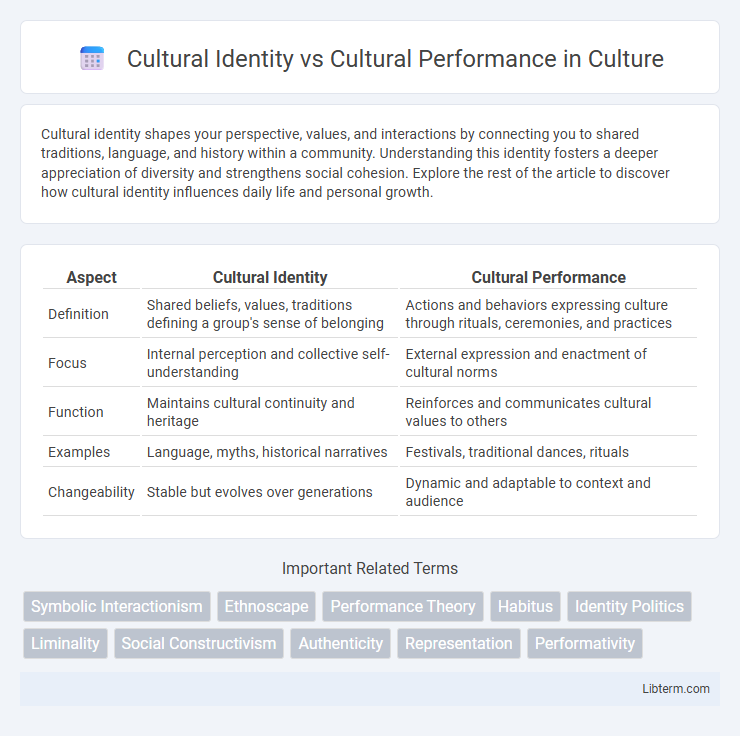Cultural identity shapes your perspective, values, and interactions by connecting you to shared traditions, language, and history within a community. Understanding this identity fosters a deeper appreciation of diversity and strengthens social cohesion. Explore the rest of the article to discover how cultural identity influences daily life and personal growth.
Table of Comparison
| Aspect | Cultural Identity | Cultural Performance |
|---|---|---|
| Definition | Shared beliefs, values, traditions defining a group's sense of belonging | Actions and behaviors expressing culture through rituals, ceremonies, and practices |
| Focus | Internal perception and collective self-understanding | External expression and enactment of cultural norms |
| Function | Maintains cultural continuity and heritage | Reinforces and communicates cultural values to others |
| Examples | Language, myths, historical narratives | Festivals, traditional dances, rituals |
| Changeability | Stable but evolves over generations | Dynamic and adaptable to context and audience |
Introduction to Cultural Identity and Cultural Performance
Cultural identity refers to the sense of belonging and shared characteristics that individuals or groups associate with their cultural heritage, language, traditions, and values. Cultural performance involves the expression and enactment of cultural identity through rituals, ceremonies, art, and everyday practices that convey meaning and reinforce social bonds. Understanding the dynamic between cultural identity and cultural performance highlights how culture is both an internalized sense of self and an outward practice that shapes community cohesion.
Defining Cultural Identity: Core Concepts
Cultural identity encompasses shared values, beliefs, traditions, language, and practices that define a collective group's sense of belonging and self-understanding. Core concepts include heritage transmission, socialization processes, and symbolic expressions that persist over time, reflecting continuity and community cohesion. This identity forms the foundational framework against which cultural performance--expressive acts like rituals, ceremonies, and art--authentically represents and communicates these deep-rooted cultural elements.
Understanding Cultural Performance: Key Elements
Cultural performance encompasses rituals, ceremonies, and artistic expressions that embody communal values and historical narratives, serving as dynamic representations of cultural identity. Key elements include symbolism, participation, and context, which collectively facilitate the transmission and reinforcement of social norms and collective memory. This framework enables a deeper understanding of how cultures continually construct and negotiate identity through performative acts.
Historical Contexts: Evolution of Culture
Cultural identity reflects the collective historical experiences and shared values that define a group's sense of self, evolving through generations shaped by migration, colonization, and resistance. Cultural performance involves the active expression and reenactment of these identities through rituals, ceremonies, and artistic practices that embody historical narratives. Over time, shifts in political regimes and social structures influence both cultural identity formation and the modes of cultural performance, highlighting dynamic historical contexts.
Intersections and Divergences Between Identity and Performance
Cultural identity embodies the deeply rooted sense of belonging to a specific group defined by shared values, traditions, and history, while cultural performance manifests through enacted practices like rituals, ceremonies, and artistic expressions that communicate and reinforce this identity. The intersection between identity and performance lies in how performances both reflect and shape cultural identity, serving as a dynamic medium for communal storytelling and identity validation. Divergences arise when performances are adapted, commercialized, or appropriated, potentially altering or fragmenting the authentic cultural identity they aim to represent.
Factors Shaping Cultural Identity
Factors shaping cultural identity include language, traditions, social norms, and historical context, all of which influence individuals' sense of belonging and self-perception. Cultural identity is deeply rooted in shared experiences and collective memory, while cultural performance reflects the outward expression of these identities through rituals, art, and social behaviors. These factors interact dynamically, shaping both personal identity and community cohesion.
The Role of Performance in Expressing Culture
Cultural performance plays a vital role in expressing cultural identity by embodying shared traditions, values, and social norms through rituals, ceremonies, and artistic expressions. These performances serve as dynamic mediums for communities to communicate their heritage, reinforce collective memory, and negotiate contemporary social realities. By enacting symbolic acts, cultural performance bridges the gap between individual identity and broader cultural narratives, fostering a sense of belonging and continuity.
Media and Modern Representations of Culture
Media shapes cultural identity by portraying diverse narratives that influence public perception and personal self-concept. Modern representations often commodify cultural elements, turning performance into spectacle that can both preserve and distort authentic traditions. Digital platforms amplify cultural performances, enabling global audiences to engage while challenging static notions of identity.
Challenges and Controversies in Distinguishing Identity from Performance
Distinguishing cultural identity from cultural performance presents challenges such as the risk of oversimplifying complex traditions into mere spectacles, which can distort the authentic meaning and significance of cultural practices. Controversies arise when cultural performances are commodified or staged for external audiences, leading to debates about authenticity, appropriation, and the dilution of deeply rooted identity markers. This tension complicates efforts to preserve cultural heritage while engaging in public expression, often leaving communities divided over the boundaries between genuine identity and performative representation.
Future Perspectives on Cultural Identity and Performance
Future perspectives on cultural identity emphasize its fluidity and hybrid nature in an increasingly globalized world, where traditional boundaries blur due to digital connectivity and migration. Cultural performance, viewed as a dynamic expression of identity, will likely integrate emerging technologies, enabling more interactive and immersive experiences that reflect evolving societal values. Scholars predict that the interplay between cultural identity and performance will drive innovation in education, media, and community engagement, fostering inclusive narratives that adapt to diverse, multicultural contexts.
Cultural Identity Infographic

 libterm.com
libterm.com